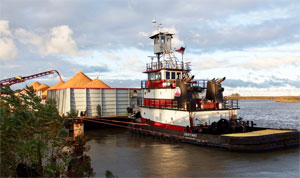Without standard clean sand, you can’t create the universal building material, concrete. And with the scale of construction in any large city — any “concrete jungle” — the appetite for sand is immense.
New York City is no exception. While New York Sand & Stone (NYS&S) has the reputation as “the city quarry,” the real source for its sand is Salem, N.J., a small port on Delaware Bay 30 hours away by boat. The tugboat Daisy Mae and barge CMT Y NOT 2 move sand thousands of tons at a time. One tug, one barge and a crew of five can transport the equivalent of hundreds of dump-truck loads.
The enterprise referred to as “sand mining” takes place 10 miles inland from the Salem port. At the mine, the sand is excavated, then washed, screened and classified before being trucked to a terminal on the Salem River and transferred to CMT Y NOT 2, a 330-by-78-foot ABS-classed deck barge with 18-inch bin walls. Loaded to its proper marks, the barge holds between 8,000 and 9,000 tons for the 30-hour trip back to the NYS&S terminal at 25th Street in Brooklyn. Pushing that barge is Daisy Mae’s principal occupation.
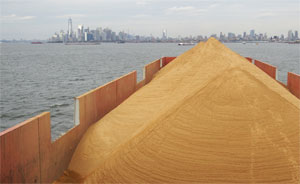 |
|
Loaded with its key ingredient for concrete, barge CMT Y NOT 2 approaches the Brooklyn NYS&S terminal. The barge holds between 8,000 and 9,000 tons of sand. |
“The goal is two round-trips (per week), four loads per two-week hitch,” according to Mark Pearson, senior captain and vessel manager for Coeymans Marine Towing (CMT). “But so far that fourth trip has been elusive, mostly because of weather.”
The challenges of the run are common to all tugboats in the near-coastwise trades: shoals, recreational and fishing boats, and the weather. Part of the weather challenge is navigating the Salem River, a transit of several miles from the Delaware Bay channel to the loading dock. The river ices up in cold months, docked vessels can constrict an already narrow waterway, and there are unidentified underwater obstructions near the dock.
The river, actually a narrow tidal creek, has a brisk current. In a blowout tide, when strong winds can increase the ebb and dramatically decrease depths, the period of adequate water for the deep-draft barge (20.5 feet) can be cut short. “Given the size of the barge, it’s always tricky,” Pearson said. On a recent northbound trip, he had to contend with gusts up to 46 knots on the beam while in the creek.
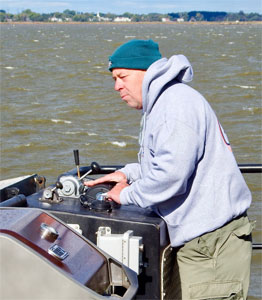 |
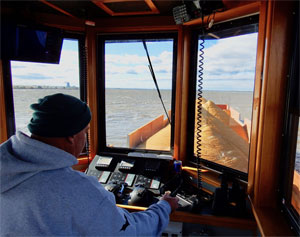 |
|
|
Capt. Mark Pearson mans Daisy Mae’s aft helm station as the crew puts the barge on the wire for the ocean hours of the run from Salem, N.J. |
Pearson guides the tow out of the narrow twisting channel of the Salem River despite winds over 40 knots. |
“Getting into the Salem River is challenging too, because a light barge is a huge sail,” Pearson said, adding that the tug approaches the terminal with the empty barge alongside. “With her triple screws, Kort nozzles and flanking rudders, Daisy Mae keeps the barge exactly where you want it.”
On the southbound run, the light barge is on the wire; the crew switches to an alongside tow for maximum control only in the last three miles to the dock. Once CMT Y NOT 2 is loaded, Daisy Mae switches to push gear to maneuver the barge along the winding channel out to Delaware Bay, visibility over the heaping piles of sand afforded by the 41-foot height of eye in the upper wheelhouse.
Once into the main channel in Delaware Bay, the crew puts the loaded barge on the wire, a process requiring speed, teamwork and precision. Many hours later, as the tow approaches the Narrows into Upper New York Bay, those connections need to be broken down and reconfigured either in push mode or alongside.
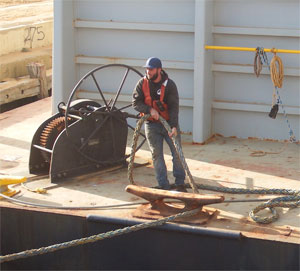 |
|
Deck hand Craig Baker cleats in at the NYS&S dock in Brooklyn. Daisy Mae, its barge and five-man crew transport the equivalent of hundreds of truckloads of sand on each voyage. |
Patrick Alfisi, mate on Daisy Mae and a 2011 graduate of SUNY Maritime, identifies what he enjoys most about the sand run: “It’s a nice blend of coastal towing and close-quarters work.”
Daisy Mae, measuring 83 feet by 31 feet with a 10-foot depth, was designed with waterways like the Salem River and the New York creeks in mind. The shallow-draft tugboat has over 3,000 horsepower available with the third engine online. If the third engine is unnecessary, it can shut down, increasing fuel economy. Twenty of the 30 hours of the trip along the New Jersey shore are coastwise, another challenge in certain wind conditions, but as Pearson said, “She’s a good sea boat.” Since leaving Rodriguez Shipbuilding in Coden, Ala., in October 2017, Daisy Mae has seen a wide variety of weather conditions, working as far south as Puerto Rico and as far north as Maine.
Daisy Mae is the largest and most recent addition to the fleet at CMT, one of the Carver Companies. When Carver Laraway created the firm in 1989, his focus was excavation in the Albany, N.Y., area, digging basements for residential developments. Stephen Kelly, senior vice president of sales and business development at Carver Companies, explained the shift to owning tugs and barges. “When the excavation company couldn’t get deliveries on time, Carver started a trucking company,” he said. “When he couldn’t get sand on time, he bought a sand pit. When he couldn’t get stone, he bought a quarry. When he couldn’t get asphalt, he bought an asphalt plant. Likewise, when he couldn’t get materials to his ship terminal in time, he decided to buy barges and tugboats.”
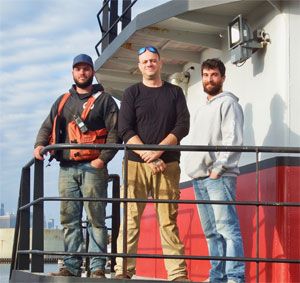 |
|
Their voyage completed, deck hands Craig Baker, left, and Mike Grooms, center, stand with mate Patrick Alfisi with the New York skyline in the background |
If deemed necessary, CMT may acquire an even larger tugboat designed for coastwise towing, Kelly said. The company recently bolstered its reputation in the Northeast by successfully completing tows of two 130-foot-tall, 4,000-ton heat recovery steam generators from the Port of Coeymans down to the tidewater, as well as 12 beer tanks, each 20 by 60 feet, from the Port of Albany through the Erie Canal to Rochester.
Instrumental in launching a proper fleet was the hiring of the team of Pearson and Matt Hofmann, vice president for operations at CMT. Pearson, who joined CMT in 2013, operated tugboats for decades along the mid-Atlantic states and in New York Harbor. Many of his boats provided dredge support, which is good training for barge handling and tugboat work. Pearson’s previous boat experience guided his decisions in the choice of shipyard and the design of Daisy Mae.
Given the Carver Companies’ logic in the decision-making process as described by Kelly, CMT may be adding more boats soon.
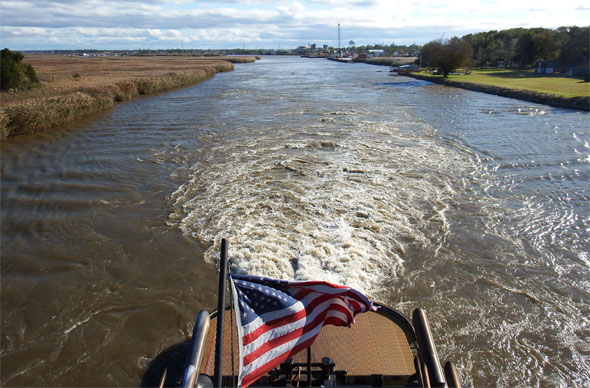 |
|
The departure from the Salem River terminal is timed to coincide with the top of the tide. |

